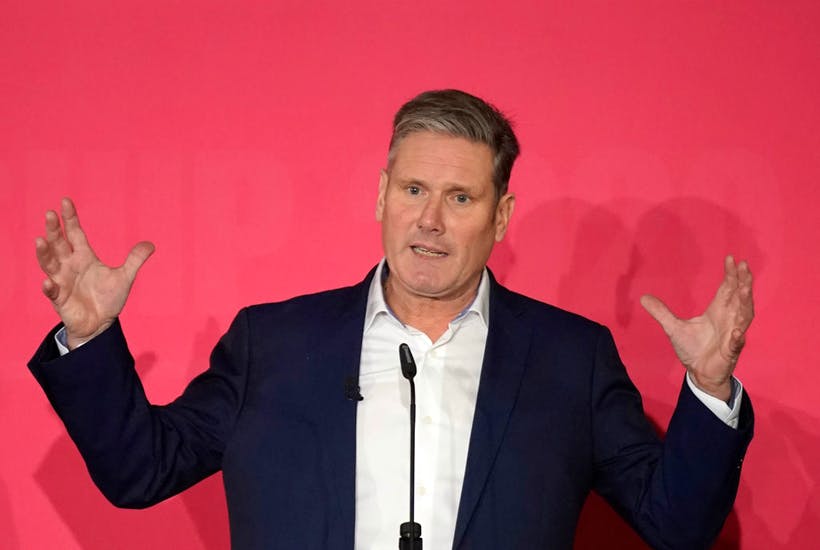Rebecca Long-Bailey denies she is the ‘Continuity Cobynism’ candidate in Labour’s leadership election. Her public statements suggest otherwise. Having given Jeremy Corbyn’s leadership a remarkable 10/10, Long-Bailey proposes to double down on the party’s 2019 manifesto commitments and simply present them in a new way. At least members know what they’re getting with a Long-Bailey leadership: more of the same but with a different face. Had Labour not suffered its worst defeat since 1935 that might have been enough to secure her victory in April.
Instead, the disaster in December means it is Keir Starmer who looks likely to become the next Labour leader. But what does he stand for?
Having supported Andy Burnham in the 2015 leadership election and Owen Smith in his attempt to unseat Corbyn a year later, Starmer is no Corbynite. Yet he has avoided directly criticising the current party leader, having coined the mantra:
‘Don’t trash the last Labour government and don’t trash the last four years’.
Starmer wants to be seen as the candidate capable of uniting all wings of the party and so end the ‘factionalism’ which plagued the party under Corbyn. If ending division is a vain hope, the latest YouGov poll of members suggests his is the pitch which is working.
The survey supplies a possible clue as to Starmer’s unwillingness to ‘trash’ Corbyn. If he has carefully avoided rating the Labour leader, Starmer’s supporters give him an average of 5/10: 30 per cent awarded Corbyn at least 7/10. If Labour’s terrible defeat has made them, perhaps reluctantly, turn their backs on the Continuity Corbynite candidate, a significant number of Starmerites appear to want a Corbyn Lite leader.
Some cynical commentators see this as being the only reason for Starmer’s reticence in attacking Corbyn: he is vote-grubbing. But however electorally convenient it is for him, Starmer is probably genuine in positioning himself somewhere between New Labour and Corbynism: it defines his own ‘soft left’ perspective.
The term ‘soft left’ originated in 1981 when Neil Kinnock refused to support Tony Benn’s campaign to become deputy leader to indicate those critical of the Labour right’s conservatism as well as the excesses of the Bennite – or ‘hard’ – left. In Parliamentary terms, it was based in the Tribune group of MPs. But during Kinnock’s leadership, the soft left was drawn into a common front with the right as the party sought to recover from the disastrous 1983 defeat fought on a Bennite manifesto by moderating its policies. As a result, by the time Tony Blair was leader in 1994, the Tribune group had virtually ceased to exist. Subsequently ‘soft left’ loosely referred to those concerned by Blair’s embrace of the market but who were generally supportive of the New Labour government given its broadly egalitarian purpose.
The 2008 financial crash breathed new life into the soft left, legitimising its case for a greater economic role for the state and a stronger emphasis on equality, something which became the basis for Ed Miliband’s attempt as leader after 2010 to ‘move on from New Labour’. Miliband was however opposed by most MPs who continued to think that shifting even slightly from the New Labour template would lead to electoral disaster. And when Miliband’s experiment ended with defeat at the 2015 election, those wanting to replace him as leader queued up to castigate his ‘anti-business’ agenda.
There was one exception to this chorus: Jeremy Corbyn, long-time member of the Bennite hard left. He was elected leader by members believing Miliband had gone nowhere near left enough: Long-Bailey has even recently implied his leadership was ‘Tory Lite’. And since 2015 – thanks to a legitimacy he enjoyed as the first leader directly elected by the membership, something which sidelined MPs’ authority to an unprecedented extent – Corbyn reset Labour policy. Untouched by the Blairite fear that radically challenging the free market would lose votes, the 2017 election result suggested his more combative approach could be a vote-winner – if not quite an election-winner.
As a member of the soft left, Starmer therefore owes much to Corbyn’s leadership. For Corbyn has made the party open to the kinds of policies of which Ed Miliband might only have dreamed of while weakening the opposition of MPs who made Miliband’s life as leader such a misery.
In 2010, Miliband attracted the nominations of just 25 per cent of MPs whereas Starmer has just won the support of 42 per cent: he is unlikely to face much criticism from a parliamentary Labour party simply grateful to be rid of Corbyn.
Arguably then, should Starmer win in April, he will triumph as the supercharged Continuity Miliband candidate. That is where he will start, yet of course, over time, things can quickly change: Kinnock began in 1983 as a man proud to be called a socialist, but, in the pursuit of votes, ended laying the foundation of New Labour.
Quite where Starmer will take Labour given his vague desire to be both ‘radical and relevant’ remains an open question. There is a vast amount of political ground between not ‘trashing’ New Labour and Corbynism. One thing seems clear, though: Starmer’s aim is to succeed where Ed Miliband failed.
Steven Fielding is professor of political history at the University of Nottingham and is writing ‘The Labour Party: from Callaghan to Corbyn’ for Polity Press, to be published in 2021. On Twitter he is @PolProfSteve






Comments